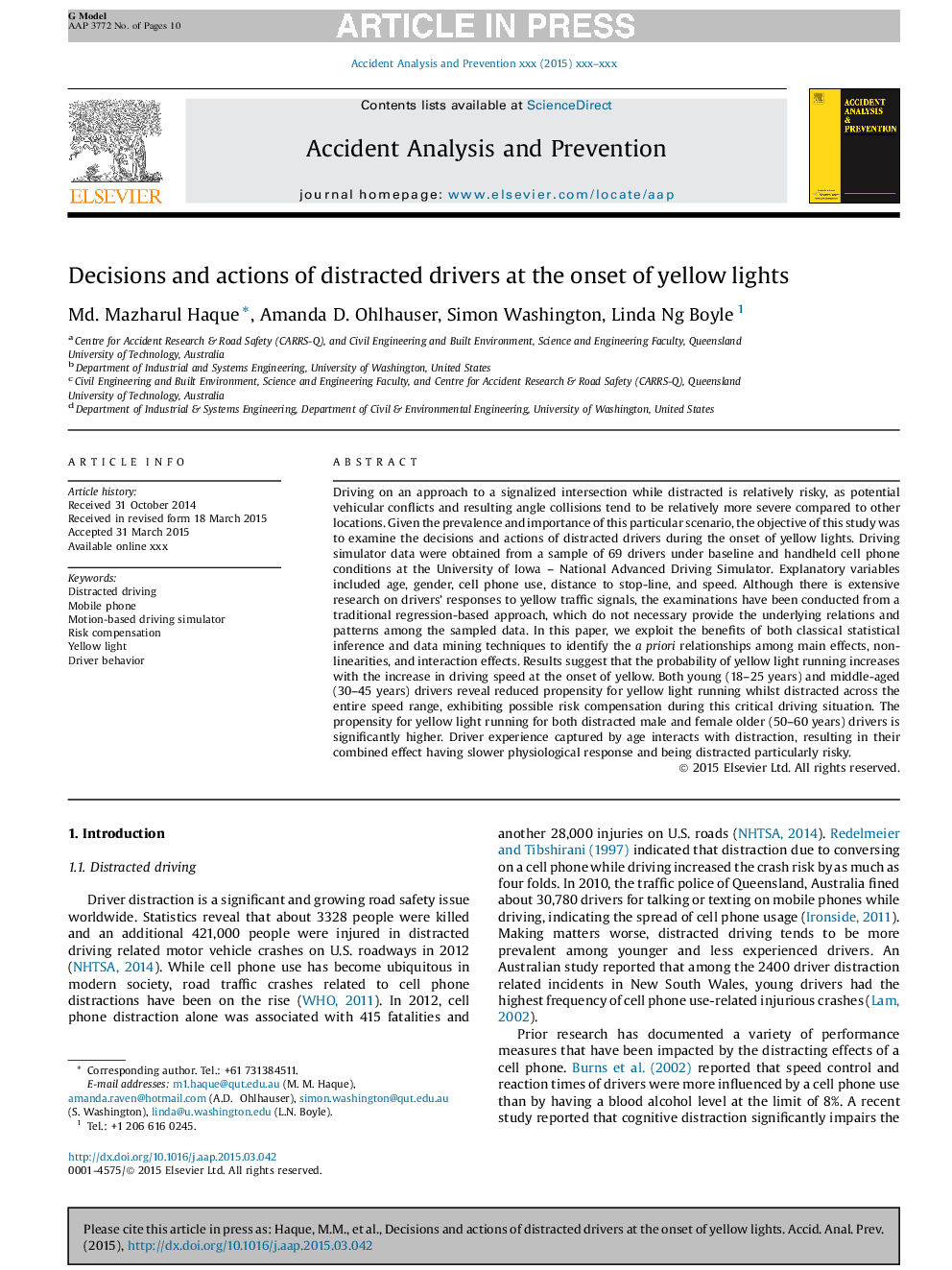| کد مقاله | کد نشریه | سال انتشار | مقاله انگلیسی | نسخه تمام متن |
|---|---|---|---|---|
| 6965313 | 1452902 | 2016 | 10 صفحه PDF | دانلود رایگان |
عنوان انگلیسی مقاله ISI
Decisions and actions of distracted drivers at the onset of yellow lights
ترجمه فارسی عنوان
تصمیمات و اقدامات رانندگان مزاحم در هنگام زنگ زرد
دانلود مقاله + سفارش ترجمه
دانلود مقاله ISI انگلیسی
رایگان برای ایرانیان
کلمات کلیدی
رانندگی منحرف تلفن همراه، شبیه ساز رانندگی حرکتی، جبران ریسک، نور زرد، رفتار راننده،
ترجمه چکیده
رانندگی در یک رویکرد به یک تقاطع سیگنال در حالی که منحرف شده است نسبتا خطرناک است، به عنوان درگیری های بالقوه وسیله نقلیه و برخورد زاویه در مقایسه با دیگر مکان ها نسبتا شدید تر است. با توجه به شیوع و اهمیت این سناریو خاص، هدف از این مطالعه بررسی تصمیمات و اقدامات رانندگان منحرف در هنگام شروع چراغهای زرد است. داده های رانندگی شبیه ساز از نمونه ای از 69 راننده تحت شرایط تلفن همراه مبتنی بر تلفن همراه و دستی در دانشگاه آیووا - ملی پیشرفته رانندگی شبیه ساز به دست آمد. متغیرهای توضیحی شامل سن، جنسیت، استفاده از تلفن همراه، فاصله تا خط متوقف و سرعت است. اگرچه تحقیقات گسترده ای در مورد پاسخ های رانندگان به سیگنال های ترافیکی زرد وجود دارد، امتحانات از یک رویکرد مبتنی بر رگرسیون سنتی انجام شده است که نیازی به ارائه روابط و الگوها در میان داده های نمونه برداری نیست. در این مقاله، از مزایای استفاده از تکنیک های استنتاج آماری کلاسیک و تکنیک های داده کاوی به منظور شناسایی روابط پیشینی بین اثرات اصلی، غیر خطی و اثرات متقابل استفاده می کنیم. نتایج نشان می دهد که احتمال افزایش نور زرد با افزایش سرعت رانندگی در شروع زرد افزایش می یابد. هر دو رانندگان جوان (18-25 سال) و میانسال (30-45 سال) نشان می دهند که تمایل به نور زرد را در حال اجرا می گذارند در حالیکه در کل رنج سرعت رانده شده اند و احتمال ریسک احتمالی را در این وضعیت رانندگی حیاتی نشان می دهند. تمایل برای نور زرد در حال اجرا برای هر دو رانندگان منفرد و زن مسن تر (50-60 سال) است که به طور قابل توجهی بیشتر است. رانندگی تجربه شده توسط سن در تعامل با حواس پرتی است، که در نتیجه اثر ترکیبی خود را واکنش فیزیولوژیک کند و به ویژه خطرناک است.
موضوعات مرتبط
مهندسی و علوم پایه
مهندسی شیمی
بهداشت و امنیت شیمی
چکیده انگلیسی
Driving on an approach to a signalized intersection while distracted is relatively risky, as potential vehicular conflicts and resulting angle collisions tend to be relatively more severe compared to other locations. Given the prevalence and importance of this particular scenario, the objective of this study was to examine the decisions and actions of distracted drivers during the onset of yellow lights. Driving simulator data were obtained from a sample of 69 drivers under baseline and handheld cell phone conditions at the University of Iowa - National Advanced Driving Simulator. Explanatory variables included age, gender, cell phone use, distance to stop-line, and speed. Although there is extensive research on drivers' responses to yellow traffic signals, the examinations have been conducted from a traditional regression-based approach, which do not necessary provide the underlying relations and patterns among the sampled data. In this paper, we exploit the benefits of both classical statistical inference and data mining techniques to identify the a priori relationships among main effects, non-linearities, and interaction effects. Results suggest that the probability of yellow light running increases with the increase in driving speed at the onset of yellow. Both young (18-25 years) and middle-aged (30-45 years) drivers reveal reduced propensity for yellow light running whilst distracted across the entire speed range, exhibiting possible risk compensation during this critical driving situation. The propensity for yellow light running for both distracted male and female older (50-60 years) drivers is significantly higher. Driver experience captured by age interacts with distraction, resulting in their combined effect having slower physiological response and being distracted particularly risky.
ناشر
Database: Elsevier - ScienceDirect (ساینس دایرکت)
Journal: Accident Analysis & Prevention - Volume 96, November 2016, Pages 290-299
Journal: Accident Analysis & Prevention - Volume 96, November 2016, Pages 290-299
نویسندگان
Md. Mazharul Haque, Amanda D. Ohlhauser, Simon Washington, Linda Ng Boyle,
